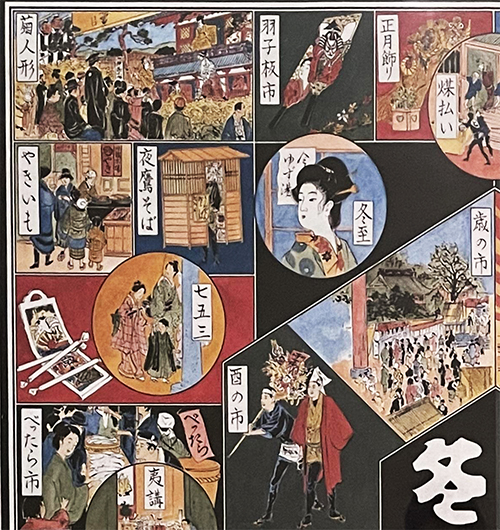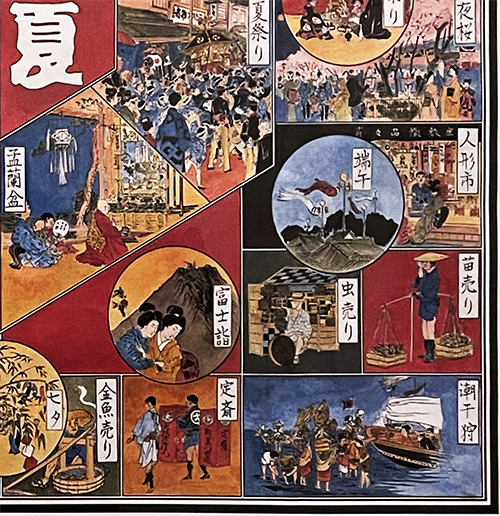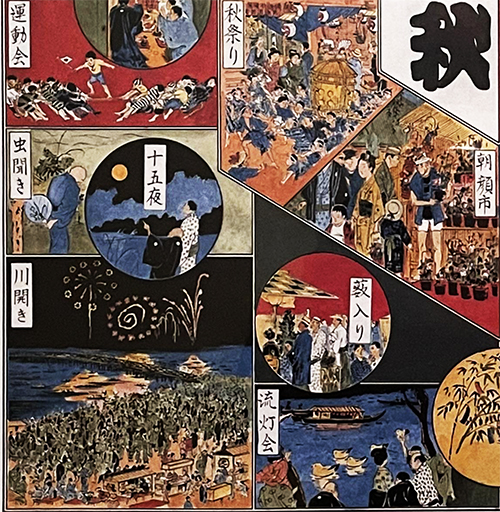

イラスト類は下町風俗資料館展示パネルから。四季変化が温暖な地域での、それも全国から集合してきた移住民たちの共有生活文化が昇華された様子が伝わってくる。
このような江戸っ子・関東地域の四季認識に対して、北海道はたとえばきょう最終日の「さっぽろ雪まつり」という最新の日本人全体が受け入れる歳時記を加えたのだと思っています。東北や日本海側地域の湿度感とは違って、それこそ比較的に湿度感が低い、乾燥した雪質のような開放感がそこにはあるように思う。たぶん東京の江戸っ子気質の関東的な湿度の少なさと共通する部分があるのではないか。
わたしは北海道で生まれ育った。大学で東京暮らしを経験しそのまま東京で就職して、札幌に転勤してその後自立した。人生時間では東京(神奈川と東京都内で居住)での暮らしが足かけ10年くらいの期間になっている。仕事上では東京との関係はさまざまに継続してきているので、主観的な意識としてはこの時間的継続感を持っている。北海道の「いちばん近い他地域」は青森ではなく東京だという認識がある。青森に行くのには札幌からだと、飛行機でも東京移動よりも時間制約が大きく「遠くなる」。
これは東京が交通体系の中心・首都であり、こちら北海道が鄙であることの必然というのが一般的理解。けれどどうも人間の気質においても、その成立過程で「近しい」共通項目が多いと気付かされる。


コトバでもわたしは北海道弁を東京でごくふつうに使ったりする。まぁ全国どこでもですが(笑)。あんまりそれを恥じるという認識を持っていない。この北海道弁は全国からの移民が混合して形成された言語であって、そういう意味で地域性というよりも「共通性」のようなものが基盤であり、そこに寒冷地的な共感文化が微妙にブレンドされたものと思っている。江戸っ子の話し言葉も、その成立過程を考えればやはり同様に全国からの移住民同士が、地域気候風土実感伝達要素を加味して成立させた。そして明治以降の日本社会ではそういう「共通言語化」が優勢な文化基盤になっていったのが事実。なので特段「恥ずかしがる」根拠がないと思うのです。まぁ恥ずかしがらせたいという志向は、文化的に保守的な層、主流派でいたい人が、優越意識を主張したいという理由から、鄙に対して上から目線したいだけなのだと思える。
断熱・気密化という住宅性能面の全国共通化ということは進展していくでしょうが、そういうことも良き基盤共通化だと思います。住宅というある意味では生活文化が凝縮した領域を考えて行くとき、江戸っ子や道産子が生成されたような生活文化への見方というものに現代人はもっと目を向けるべきではと思います。
English version⬇
The “Commonization” of Culture Since the Edo Period: Exploring the Shitamachi Row Houses-7
A chronicle of downtown culture. The first period was a time of “commonality” and acceptance of strangers. The Edo culture was vigorously developed by the common Nipponization of the people. The Edo culture was full of “common-ness” and acceptance of strangers.
The illustrations are from the exhibition panels at the Shitamachi Folk Museum. The illustrations show how the four seasons were sublimated into a shared lifestyle and culture in a region with a mild climate, where immigrants had gathered from all over the country.
To this perception of the four seasons in the Edo and Kanto regions, Hokkaido, for example, has added the latest seasonal calendar accepted by the Japanese people as a whole, the Sapporo Snow Festival, the last day of which is today. Unlike the sense of humidity in the Tohoku and Sea of Japan regions, I think there is a sense of openness there, like a dry, snowy climate with a comparatively low sense of humidity. Perhaps it has something in common with the Kanto-like low humidity of Tokyo’s Edokko temperament.
I was born and raised in Hokkaido. I experienced life in Tokyo at university, found a job in Tokyo, was transferred to Sapporo, and later became independent. In terms of life time, I have lived in Tokyo (living in Kanagawa and Tokyo) for a total of about 10 years. I have a sense of temporal continuity in my subjective consciousness, as I have had various ongoing relationships with Tokyo in my professional life. There is a perception that the “nearest other region” in Hokkaido is not Aomori but Tokyo. Aomori is “farther away” from Sapporo than Tokyo, even by air, due to the time constraints.
The general understanding is that this is inevitable because Tokyo is the center of the transportation system and the capital, and Hokkaido is remote. However, I have noticed that there are many similarities in the human temperament and in the process of its formation.
I use the Hokkaido dialect in Tokyo quite commonly, even in Kotoba. Well, anywhere in Japan (laughs). I am not ashamed of it. The Hokkaido dialect was formed by a mixture of immigrants from all over Japan, and in that sense, it is based on a kind of “commonality” rather than regionality, which I think is a subtle blend of the cold-weather culture of empathy. The spoken language of the Edo period was also formed by immigrants from all over the country, who added the element of transmission of a sense of local climate and customs to it. And it is a fact that such “common language” became the predominant cultural foundation in Japanese society after the Meiji period. So I don’t think there is any particular reason to be “shy” about it. Well, it seems to me that the orientation of wanting to embarrass is just a culturally conservative group, people who want to be in the mainstream, wanting to look up to the remote people for the reason of wanting to assert their sense of superiority.
I think that the national standardization of housing performance, such as insulation and airtightness, will continue to progress, but I think that this is also good basic standardization. When considering housing, an area where life culture is condensed in a sense, I think that people today should pay more attention to the way of looking at life culture that was created by the Edokko and Dosanko.
Posted on 2月 11th, 2023 by 三木 奎吾
Filed under: 住宅マーケティング, 日本社会・文化研究







コメントを投稿
「※誹謗中傷や、悪意のある書き込み、営利目的などのコメントを防ぐために、投稿された全てのコメントは一時的に保留されますのでご了承ください。」
You must be logged in to post a comment.